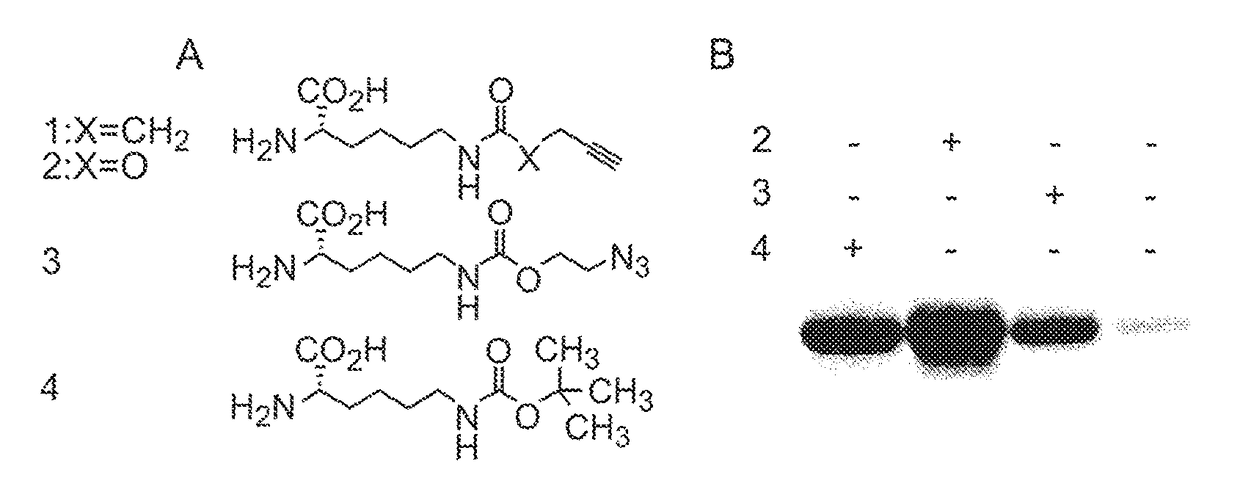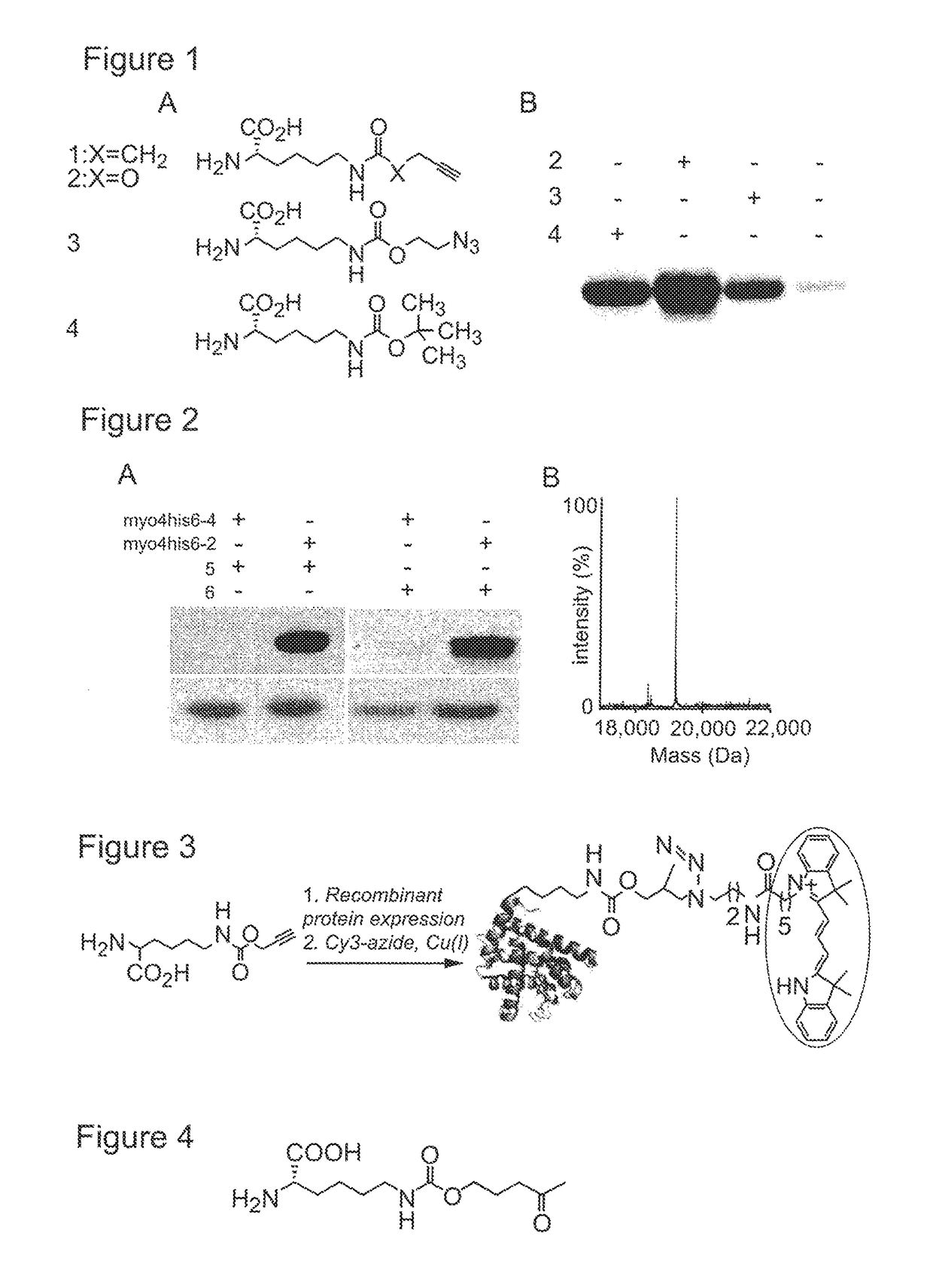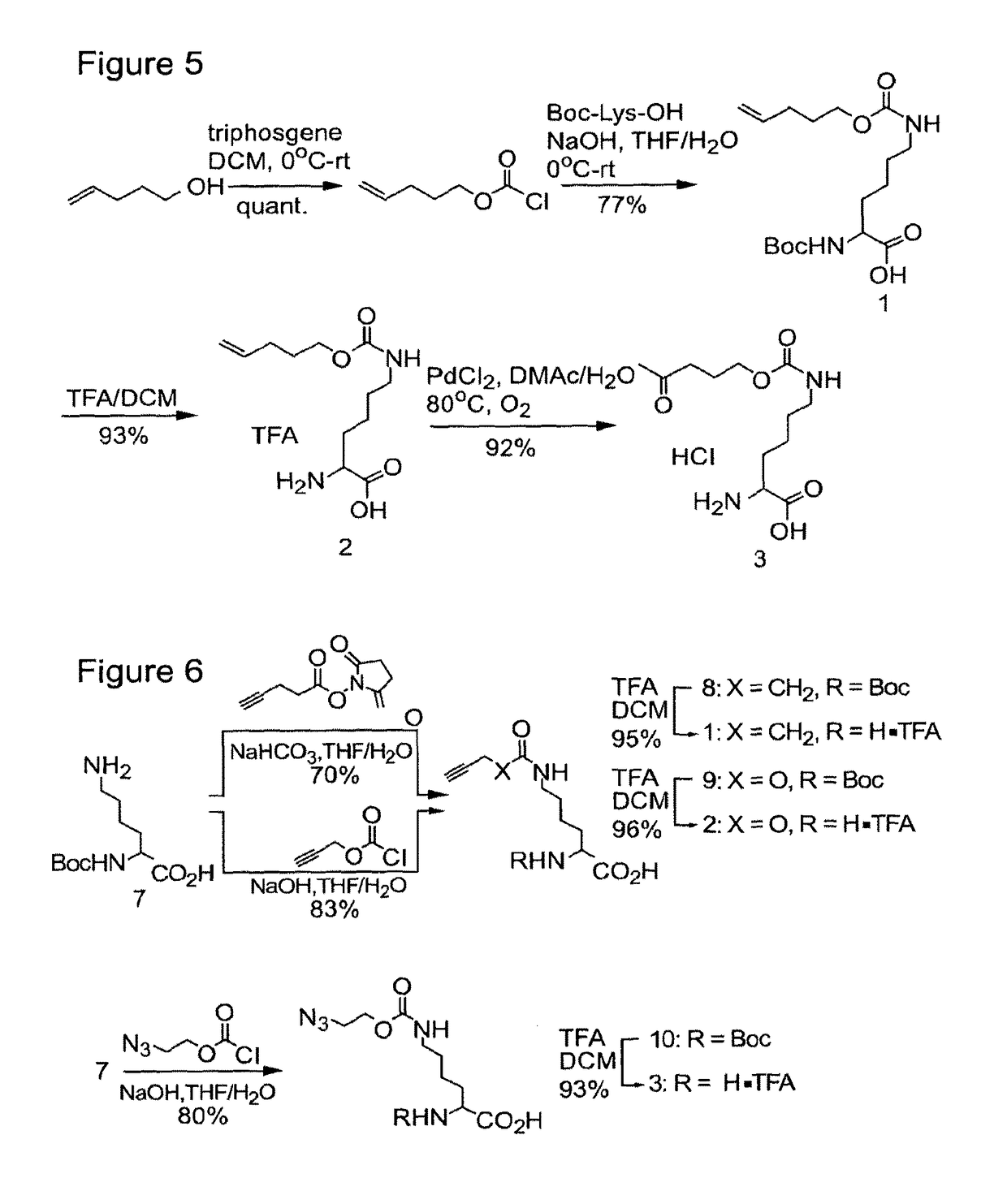Methods
a technology of polypeptides and methods, applied in the field of polypeptide (s), can solve the problem that the strategy is almost certain to destroy the functionality of proteins
- Summary
- Abstract
- Description
- Claims
- Application Information
AI Technical Summary
Benefits of technology
Problems solved by technology
Method used
Image
Examples
example 1
[0120]Here we describe the synthesis and genetic incorporation of aliphatic azides and alkynes into proteins using the natural MbPyIRS / tRNACUA pair and the efficient bio-orthogonal labeling of these amino acids using [3+2] cycloaddition (‘click’) chemistry(13).
[0121]We designed and synthesized aliphatic, photostable amino acids 1 and 2 that link the alkyne functional group to a lysine residue via an amide or carbamate bond (FIG. 1). These amino acids were synthesized in 2 steps and 70-80% yield from commercially available material (Supplementary Scheme 1, Supplementary FIG. 1& Supplementary Methods).
[0122]To investigate whether 1 and 2 are substrates for the MbPyIRS / tRNACUA pair, we transformed E. coli with pBKPylS10 (which encodes MbPyIRS) and pMyo4TAGPylT-his610 (which encodes MbtRNACUA and a C-terminally hexahistidine tagged myoglobin gene with an amber codon at position 4). We added 1 or 2 (1 mM) to log phase cells and induced myoglobin-his6 expression. While in the presence of ...
example 2
tion of Aliphatic Ketone
[0135]A suitable amino acid / derivative bearing aliphatic ketone for incorporation according to the present invention is shown in FIG. 5.
[0136]An exemplary synthesis is described in detail below:
(S)-2-(tert-butoxycarbonylamino)-6-((pent-4-enyloxy)carbonylamino)hexanoic acid (1)
[0137]To a solution of 4-pentenyl alcohol (100 mg, 1.16 mmol) in DCM (1 mL) at 0° C. was added triphosgene (381 mg, 1.27 mmol). After the reaction was stirred for 8 h, the solvent was evaporated without heating and the residue dried under vacuum for 1 h. The prepared 4-pentenyl chloroformate was then added directly to a solution of Boc-Lys-OH (370 mg, 1.5 mmol) in H2O:THF (5 mL:5 mL), at 0° C. containing NaOH (120 mg, 3 mmol). The reaction was stirred for 8 h, allowing it to warm to r.t. The reaction was subsequently acidified with cold 1 M HCl (20 mL) and extracted with EtOAc (25 mL). The organic layer was dried over Na2SO4, filtered and evaporated, affording 1 in 77% yield (350 mg, 0.9...
example 3
tary Methods
(S)-2-(tert-butoxycarbonylamino)-6-pent-4-ynamidohexanoic acid (8)
[0142]Boc-Lys-OH (1.0 g, 4.06 mmol) was dissolved in sat. aqueous NaHCO3 (10 mL), THF (10 mL) was added, the solution was cooled to 0° C., and N-succinimidyl-4-pentynoate (594 mg, 3.04 mmol) was added. The reaction mixture was allowed to stir for 10 h at room temperature. The THF was evaporated in vacuo, and the aqueous solution was cooled to 0° C. and acidified with ice-cold 1 M HCl (100 mL). The aqueous layer was extracted with ice-cold EtOAc (2×100 mL), and the combined organic layers were dried over Na2SO4, filtered and concentrated in vacuo. The residue was further purified by silica gel chromatography using DCM:MeOH (9:1) as the eluent. The amide 7 was obtained in 70% yield (695 mg, 2.1 mmol) as a white foam. 1H NMR (CDCl3): δ=1.31-1.82 (m, 15H), 2.01 (s, 1H), 2.36-2.50 (m, 4H), 3.20 (m, 2H), 4.13 (m, 1H), 5.55-5.75 (m, 2H), 6.73 (m, 1H). HRMS: m / z calcd for C16H26N2O5 [M+Na]: 349.1...
PUM
| Property | Measurement | Unit |
|---|---|---|
| mass | aaaaa | aaaaa |
| mass | aaaaa | aaaaa |
| pH | aaaaa | aaaaa |
Abstract
Description
Claims
Application Information
 Login to View More
Login to View More - R&D
- Intellectual Property
- Life Sciences
- Materials
- Tech Scout
- Unparalleled Data Quality
- Higher Quality Content
- 60% Fewer Hallucinations
Browse by: Latest US Patents, China's latest patents, Technical Efficacy Thesaurus, Application Domain, Technology Topic, Popular Technical Reports.
© 2025 PatSnap. All rights reserved.Legal|Privacy policy|Modern Slavery Act Transparency Statement|Sitemap|About US| Contact US: help@patsnap.com



